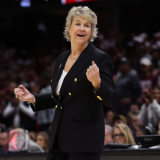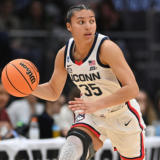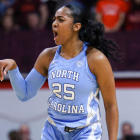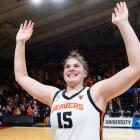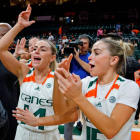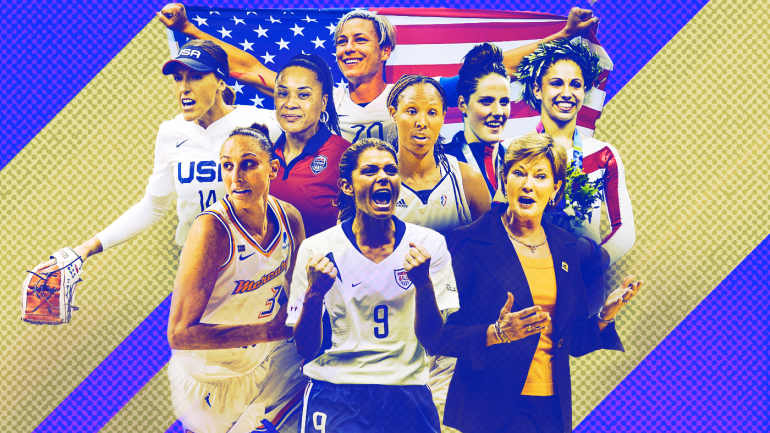
John Cook has seen the future of women's athletics. Never mind, for now, the four national championships he has won as Nebraska's volleyball coach, making it possibly the most successful at an athletic department that has ridden football excellence for decades.
That future was revealed to him decades ago as a high school coach in San Diego. To continue coaching football at Francis Parker School -- a college preparatory institution -- Cook had to become a full-time teacher. To do that, he agreed to coach girl's volleyball, basketball and softball "doing everything".
"Doing everything" meant training the girls the same way he trained the boys in football.
"It was cool to go watch the girls play. I was coaching them like football. … I was really hard on them," Cook recalled. "We had 6-mile runs in the soft sand down in Mission Beach. They had to hit a certain time. The girls loved it even though they had a hard time with it. They loved being pushed."
That contributed to one man's revelation of the female athletic condition. Cook's is merely one of the leading voices in this significant month of a significant year.
While the NCAA Women's Basketball Tournament rages during Women's History Month, there is some fitting history.
Title IX -- the federal law that prevents discrimination on the basis of sex by any education program receiving federal funds -- turns 50 this year.
Middle age sits well with Title IX. There has never been a better time to be a female athlete. Increasingly, they are icons, heroes, bad-asses.
Here's soccer star Megan Rapinoe of the United States women's national soccer team.
"I've been devalued. I've been disrespected and dismissed because I am a winner," she said during a White House appearance last year. "I have been told I don't deserve any more than less because I am a woman."
Last month, the women's national team won a $24 million equal pay settlement with the U.S. Soccer Federation. Rapinoe was one of five high-profile players who filed the original complaint in 2016 with the Equal Employment Opportunity Commission.
Progress is ... speeding up
Significant strides have been made in terms of success, attention and equality, but there are still miles to go.
Ali Kershner rocked college athletics to its core last year. Then a Stanford sports performance coach, her Instagram post of an inadequate weight room at the NCAA Women's Tournament went viral.
The NCAA was admonished and embarrassed. It was also spurred to action.
A historic women's tournament kicked off last week. For one, the field was expanded to 68 teams, matching the men. It's also the first time the term "March Madness" has been expanded to apply to the women's event as well as the one featuring the men.
"I really feel like women's sports has come into a new era this past year," Kershner told CBS Sports. "Maybe it's the new stories coming out about the women's national soccer team and settling with U.S. Soccer. The WNBA has gotten a lot more attention recently. Maybe it's the [name, image and likeness rights]. I feel like we've turned a page in women in sports getting recognition."
All of the above were at least inspired -- certainly legally supported -- by Title IX. The entire women's tournament infrastructure has improved amid the awareness Kershner spurned. Her post literally brought the women's tournament on the same level as the men's in many respects.
As for that weight room post that changed the world? Shortly after Kershner's posting, Cook said the NCAA called his strength coach, Brian Kmitta. The 2020 volleyball championship – pushed to April 2021 in Omaha due to COVID-19 -- came a month after the beginning of the women's tournament. The NCAA needed to catch up -- fast.
A new, comprehensive weight room was built by Kmitta.
"[The NCAA] called him because they didn't want to be embarrassed twice," Cook said.
Things are far from perfect, but the criticisms have given Kershner a sense that something big is on the horizon.
This month, the women will receive the same perks -- lounge areas, gifts, swag bags, per diem and travel -- as the men. The two women's championship teams will hold open practices on the Saturday before their national championship game (April 2).
Last year, the women's title game between Stanford and Arizona rated better (4.1 million viewers) than an average NBA playoff game. Perhaps most impressive: All three divisions' Final Fours will be played next year in the Dallas-Fort Worth area as a year-long celebration of Title IX continues.
"The real impact of Title IX was the access to education," said Chris Plonsky, executive senior associate athletic director at Texas. "Thousands of women who said, 'I got to go to school, got a full scholarship, got educated, I can take care of myself, my spouse, my family.' That's the real story."
Plonsky came to Texas for a second time in 1993 -- she had been a sports information director from 1982-86 -- after a landmark court ruling that determined women were underrepresented on the campus. Three women's teams were added. Three years later, Texas joined the Big 12 helping enhance the bottom line as one of the most dominant athletic departments in the country.
Since 1993, Longhorns football has one national championship and three conference titles. The three sports added after that year -- softball, soccer and rowing -- have combined for 16 conference titles and a 2021 national championship in rowing.
Plonsky is a member of the NCAA Division I Volleyball Committee, helping make decisions for a sport that became a beacon on the hill for young women. At Nebraska, volleyball is a revenue sport and a whole hell of a lot more successful than football or men's basketball. The Huskers last had an empty seat for a match in 2001.
The sport's Final Four is routinely sold out. Texas finished fourth in attendance in 2021.
"We can't stuff another body in our gym," Plonsky said.
"It's a great team sport," Cook said. "Women love to be a part of teams. You can be tall, you can be short, you can find a place to play. The other biggest thing is they get to be athletic. The net is lower than the men. I would equate that with women's basketball, if they lowered the rim a foot. In volleyball, they can be just as dynamic as the men because the net is lower."
It doesn't stop there. ESPN announced in February it sold all its advertising inventory for the women's basketball tournament. The game's biggest coaches might as well be activists for their gender.
South Carolina's Dawn Staley not only advocates for women but women of color getting the same NIL money as their male counterparts. Her Gamecocks are attempting to go wire-to-wire as the No. 1 team in the nation.
The fact remains most young women growing up today may not even know the details of Title IX. It's wording contains nothing in reference to sports. They have been brought up demanding equality.
One of Kershner's mentors, Andrea Hudy, is among the most respected strength coaches in any college sport. Stanford coach Tara VanDerveer immediately released a statement supporting Kershner's post.
While Oregon's Sedona Prince has gotten most of the credit for her viral TikTok chronicling the inequality in San Antonio, Kershner posted the first images.
"In my family, I was raised to always speak up for what's right," Kershner said. "My mom is the strongest person I've met in my life. She taught me, if something isn't right, you need to speak up about it."
That profile also fits Stef Strack, who spent 15 years as an executive at Nike. A few years ago, she gave up a corporate career to found the Voice in Sports Foundation, a nonprofit that teaches high school- and college-age women how to advocate for their rights. Strack's goal is to find at least one VIS advocate in all combined 23,000 high schools and colleges in the country.
"After they go through the training, you should see their faces. Their eyes light up," Strack said. "All the sudden, they see and understand their rights as women in high school and college. That's when you start getting real change happening."
Strack is a shining example of what gender equity has wrought. She learned to ski at age 2, won a Junior Olympics medal in the downhill and played Division I soccer at Montana.
Now, Strack is working with Rep. Alma Adams (D-NC) on a federal bill to strengthen education and enforcement of Title IX.
The plan is for the bill to be introduced June 23, the actual 50th anniversary of Title IX.
While things have never been better for female athletes, significant hurdles exist in the hopes of reaching true equality.
There is a $1 billion shortfall in scholarship money available to women compared to men. Due to a loophole in Title IX compliance, male practice participants for women's teams can actually get counted as female. In 2020, Vanderbilt's Candice Storey Lee became only the fifth female athletic director at a Power Five school.
Women are just now breaking through as coaches and administrators in the major men's sports. On Tuesday, Milan Bolden-Morris at Michigan became the first female football graduate assistant in the Power Five. Becky Hammon is earning $1 million per year as coach of the WNBA's Las Vegas Aces. Hammon, a former San Antonio Spurs assistant under Gregg Popovich, is being groomed to become the NBA's first female head coach.
That's whole other chapter to be written.
"People don't like something new and different," Hammon said. "It's uncomfortable."
Except women already officiate college basketball, college football, NBA and NFL games. We should be way past the point of noticing. In February 2021, Sarah Thomas became the first woman to officiate a Super Bowl.
Cook is a youthful 65. The former high school football coach has become a leading women's advocate, even if he doesn't realize it. With his experience and success, Cook gets the right attention.
For years he has advocated for a Taraflex floor at national events. The surface is considered the industry standard. When he finally spotted one at an NCAA event, Cook knelt down and kissed it.
"I've probably pushed too hard on many things fighting for women's athletics," he said. "I probably pissed a lot of people off. I'm probably considered by a lot of administrators and people at the NCAA, 'He's kind of the bad boy.'"
What's next?
NIL has been a smashing success for women. Two-thirds of NIL opportunities go to men, but if you remove football, 60% of the remainder goes to women. Fresno State's famed Cavinder twins -- Haley and Hanna -- announced last Monday they are transferring to play basketball elsewhere. They will carry with them a trunk of NIL funds, including money earned from their own apparel line. They have also signed NIL deals with WWE; they currently promote the brand and have options to become professional wrestlers when their college careers end.
Gymnasts have become rock stars. In the first six months of The Gator Collective -- a third-party NIL company supporting University of Florida athletes -- twice as many female athletes signed deals as non-football male athletes.
"We've also found that the female athletes, particularly gymnasts, have organized business plans, excel at creative content and brand promotion," said Jen Grosso, Gator Collective executive vice president. "They tend to have multiple other NIL deals going on."
The upward arc of women's sports is no longer surprising; now, it's now expected.
In 2021, the Women's College World Series (softball) was the most-watched ever. Same for the Division I women's soccer championship. In volleyball, viewership for the 2021 championship match was up 28%. Last year's women's Final Four was the most-watched in a decade. Yes, that is WNBA star Candace Parker featured on CBS and Turner's NCAA Men's Tournament coverage.
It's no secret the Olympics, especially winter, are built around female viewership. Women received a record 60% of the primetime Olympic coverage, according to FiveRing.com. Kansas City is building the first stadium specifically for women's soccer in the United States. The $70 million project will be the home of a National Women's Soccer League franchise.
Title IX isn't going anywhere. In fact, after half a century, it is just getting warmed up.






